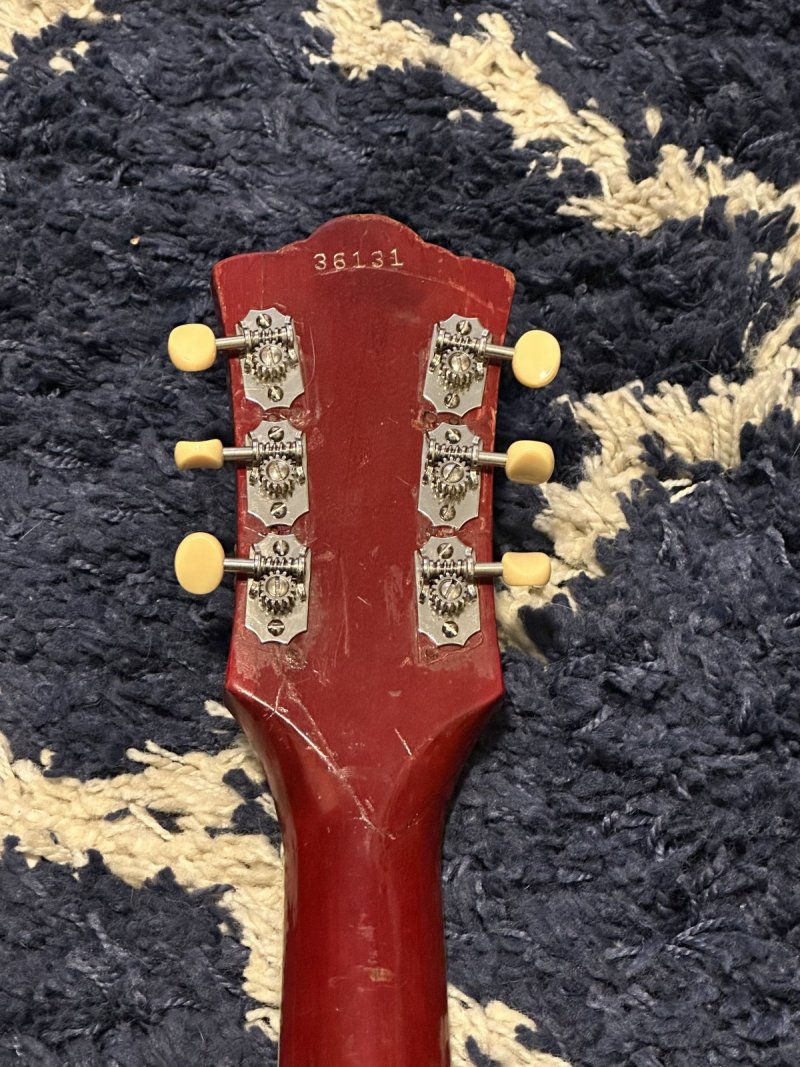rbrcbr
Member
Hey! Sorry, busy week with not enough downtime to reply.Well, I beg to differ. Guild (and Gretsch) neck angles being too shallow is a pretty common problem, yes, problem on guitars that have a factory Bigsby. It's pretty common for Starfire III's (or indeed Gretsch 6120's and Tennesseans) to have a neck angle that is too shallow to work properly with a Bigsby B6 or similar. Strung up and tuned to pitch, the strings won't stay put in the bridge saddle because there's hardly any (or no) break angle from the tailpiece to the bridge.
If there's no Bigsby involved though, the guitar plays correctly and the strings say put in the bridge saddle even under heavy strumming.
And the bridge height has a definite effect on sound - and that's where I want to add my two cents : a steep break angle from string to bridge seems like a good idea, but it doesn't always translate into a great sounding guitar. Quite a few vintage Gibson aficionados know this, and purposely look for Les Pauls and 335's with a low-ish neck set/bridge height, because they tend to sound great. It's one of the many things Norlin changed in the 70's - and it's not for the better. There are Norlin 335 type guitars out there with very steep neck sets, very tall bridges, and soundwise....all the charm of a banjo.
guitars with a tailpiece and a tall bridge saddle can have an exaggeratedly agressive attack on the front of the note, so much initial resonance it really cuts into the bloom and sustain of the note that's being plucked. All pick attack and brash upper midrange.
You really notice this on typical 1950's and 1960's German acoustic archtops like Hofners and the many other smaller German makers : an awful lot of them have very tall neck sets and the resulting tall bridges and extreme break angles - and they sound pretty ugly. All brash attack in the front of the note, the pick stroke, and very little anything after. They're great for agressively strummed rhythm that needs to be brash and all upper midrange because it almost functions as a snare or hi-hat in a band setting, but very little else. The ones that have some kind of floating pickup installed are just as bad - not a very attractive or useable sound unplugged OR plugged in.
And yes, hollowbody M75's and M65 sound pretty small and plinky acoustically, but they're not acoustic guitars nor were they designed to be. They tend to sound pretty spectacular plugged in. I just played an acquaintace's 1957 M75 again last week, and when I lifted it out of the case and gave it a strum or two unplugged, I was reminded of how "cigar-box-y" they can be unplugged, but boy....was it ever glorious plugged into an amp. I cursed out loud again, as in "why didn't I get one of these when they were still semi-affordable!?!"
Another thing to keep in mind is that M-75's came out on the heels of Gibson's early "no neck angle" Les Pauls, with the funny trapeze tail with strings that came out from under the bar bridge instead of laying on top of them, making palm muting all but impossible. But now that clever intonated very flat replacement tailpieces for those 52/53 Les Pauls are available, you don't hear anyone complain about how they sound - because they sound great.
About neck angles drifting - it's a very real problem on flattops, but on laminated archtop guitars I'm pretty sure I've seen more guitars with sagging top arches requiring a *taller* bridge over the years as a result than archtops that needed the bridge saddle shaved because the neck angle shifted - the typical Guilds and Gretsches you see with shaved bridge saddles left the factory with an unusually low neck angle - Gretsch is very well known for an almost complete lack of quality control or even luthier skill on a LOT of guitars. Guild wasn't nearly as sloppy, but with neck angles on Starfires there were plenty of misses or near-misses.
Wanted to say that it probably sounds like I'm speaking in absolutes but that wasn't my intention - yeah totally, Gretsch and Guild were commonly poorly set, and vintage Gretsch guitars in particular have a reputation for being super inconsistent/not always good. I was being too broad in my reference, my intention was to refer to the "good" examples that I've been able to handle personally.
In that same sense, I was not saying that "tall" bridges are a good thing, because there is a such thing as an overset neck. I guess I should have specified that there is a sweet spot for a proper neck angle and that the M-75s I've played are always much lower than that sweet spot. I've played my fair share of vintage archtops with massive bridges and I agree with you...I don't find them to be particularly pleasant sounding/feeling. The trapeze Les Paul is a good reference point in understanding where the M-75 had come out, but even that is an entirely different animal in construction and application. The low neck angle combined with low action can be resonant, as any well put together electric guitar can be resonant, but it certainly feels like an "electric guitar". I can recognize that a '59 burst can be resonant and sound incredible plugged in, but in terms of feel, it's not going to do the fingerstyle thing very well. But maybe that's the point - the design of the M-65/M-75 was to be a unique electric guitar, not a "semi acoustic" guitar.
It's not that I want this M-65 or any M-75 to be an acoustic guitar, as it's never going to be that. I just feel that there is potential there for them to be more inline with how resonant and responsive other hollow guitars seem to be. I've just been a bit disappointed/underwhelmed every time I pick one up. The last duo jet I played had more acoustic resonance than my M-65 and both M-75s that I recently played, and that's just a chambered guitar, it's not even fully hollow. But I recognize that they sound great plugged in and that matters, I'm certainly not complaining about that.
I'm not sure that a neck set will create the acoustic response I'm hoping for, but I guess I'll keep my fingers crossed. I hadn't even realized that the neck was fully glued in all the way to the end of the fretboard, instead of having a more traditional cantilevered neck like the Starfire, so it sounds like it's going to be more of a pain to reset than anticipated.

